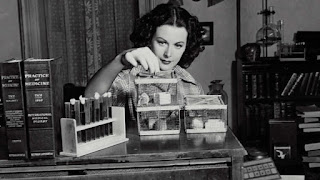Here are my reviews of Bombshell: The Hedy Lamarr Story (2017) and That Summer (2017).
I'll be honest. Even as a self-described classic film nerd, I was only marginally aware of Austrian film actress Hedy Lamarr. I knew about her controversial nude swimming scene in Ecstasy (1933) and her lawsuit against Mel Brooks for making fun of her name in Blazing Saddles (1974). (Mel loved her so much he just paid her. He figured she'd earned it by giving the world such "cinematic pleasure.") I could pick Hedy out of a lineup, but I had not seen most of her movies. In Bombshell, I learned her beautiful face, figure, and film career were just part of her story.
Born in Austria, Lamarr's natural beauty got her attention early on, and she started appearing in movies by the age of sixteen. At nineteen, she married prominent munitions manufacturer, Fritz Mandl, as one does. It being 1933 and all, Austrian munitions meant doing business with the Third Reich and state visits from Mussolini. Lamarr was Jewish, so she put two and Jew together and snuck out of her posh mansion in the middle of the night and high-tailed it to London. Her risqué scenes in Ecstasy caught Louis B. Mayer's attention, and soon the Austrian-accented beauty was brought to America to add her unique looks and style to Hollywood films until she retired in 1958.
The bombshell that Bombshell drops is that in addition to being a movie star, Lamarr was also a very talented inventor. Raised in her father's chemistry lab, Hedy had a keen scientific mind and was eager to join the war effort against the Nazis.
She helped develop a technology called frequency hopping to prevent Germans from scrambling radio signals that guided American torpedos to their target. While there was some propaganda coverage of her invention, nothing was actually done with it at the time (it included using something like a paper player piano roll). Later, her work was used to create a little thing we now know as wi-fi. Of course, because she was just a gorgeous film actress, she was not credited for her contribution for decades.
The documentary is a beautiful tribute to Lamarr's work both on-screen and off. In particular, the use of audio recordings made toward the end of her life add an authentic, human touch. Her films are not usually cited as memorable examples of great Hollywood filmmaking. Algiers (1938), Boomtown (1940), and Ziegfeld Girl (1941) stand out as good examples of the successful classic Hollywood style, and White Cargo (1942) and Samson and Delilah (1949) as examples of its excesses. It is Bombshell that will insure Hedy Lamarr has a permanent place in Hollywood history.
That Summer (2017)
I adore the documentary Grey Gardens (1975). Big and Little Edie of the titular East Hamptons decrepit manse have always held a hypnotic spell over me. Their ability to live so convincingly (and tragically) in a dream world of their own devising exemplifies how the human spirit can remake itself into whatever it wants no matter the circumstances. So when I heard there was a sort of prequel to the Maysles Brothers masterpiece, I grabbed a hand towel and a broach and headed to the IFC Center.
That Summer is directed by Goran Olsson from footage taken in 1972 by photographer Peter Beard. Beard and Beale relative Lee Radziwill were hoping to make a documentary about the reclusive and eccentric Beales, but after four reels the project was shelved. Two of their camera crew, Albert and David Maysles, would pick up the torch. The Maysles documentary would become a landmark in documentary filmmaking, while Beard's footage was assumed lost and collected dust.
Olsson bookends the now recovered four reels with the background of Beard and Radziwill and the artsy crew they hung out with. Yes, that's Andy Warhol, Paul Morrissey, Truman Capote, Mick and Bianca Jagger and even little JFK Jr. and Caroline hanging out on the beach. But the real focus is the two grand dames of Grey Gardens.
That Summer is like finding a box of old photos that you have never seen before of friends you know and love. There are Big and Little Edie as vibrant, peculiar, and irascible as we remember them. Little Edie poses in her trademark Frankenstein fashion style, vowing in whispers that she has to get the "H" out of here.
Big Edie hobbles around shooing cats away from her portrait and howling, "Edie!" in such a way that it rings throughout space and time. And the raccoons pop up through holes in the roof to eat the Wonder bread that Little Edie tosses to them.
There is nothing revelatory here. No dark secrets unearthed. We do finally meet the dreaded East Hampton Health Department, but otherwise, That Summer is not the in-depth documentary masterwork that Grey Gardens is. Olsson is showing a home movie rather than a character study. But it doesn't matter. Any time spent with these two extraordinary women is a welcome visit to a place and time that is sadly gone except for what celluloid has preserved.
I guess I accidentally had a feminism double-feature that deals with women who were so much more than what society expected of them. #westillhavealongwaytogo











